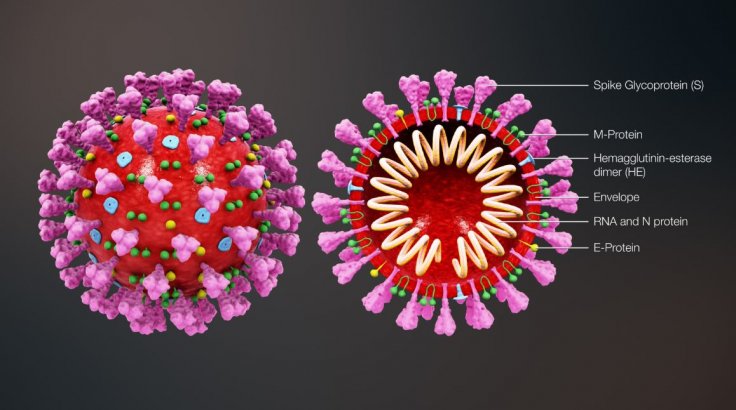As the COVID-19 pandemic continues to rage across the globe, it is not just human beings that have been ensnared within the clutches of the SARS-CoV-2 virus. Several species of wild, as well as domestic animals have been discovered to have the disease. Now, a new study states that three species are the most vulnerable to the virus other than humans—Ferrets, Cats and Civets.
According to researchers from the Centre for Genomic Regulation (CRG), dogs rounded off the list of animals that were found to be most susceptible to the virus. The findings also elucidated why certain species are adversely affected while some such as ducks, rats, pigs and chickens have remained largely unharmed by the pathogen.
"Knowing which animals are susceptible to SARS-CoV-2 helps us prevent building up animal reservoirs from which the coronavirus can re-emerge at a later date," said Dr. Luis Serrano, senior author of the study, in a statement.
How Does SARS-CoV-2 Infect Cells?

Spikes are hook-like protein structures that are found on the surface of the SARS-CoV-2 virus. These structures aid the virus in infecting cells, especially lung cells. ACE2 (Angiotensin-converting enzyme 2), an enzyme present on the cell membranes of cells in the intestines, lungs, kidneys, arteries, kidneys and heart, is targeted by the spike protein.
The infection of cells commences when the spike protein tethers to the ACE2 cell receptors through a lock-and-key mechanism. With the progression of the infection, the process of catalyzation is enabled. This promotes the release of the novel coronavirus' genetic material into the attacked cell. There are different varieties of ACE2 in human beings and other species of animals.
Probing Vulnerability of Different Species
For the study, the authors examined ten species. The first five included humans, cats, civets, dogs, and ferrets—all of which have had confirmed cases of the infection. Chickens, ducks, mice, pigs, and rats—species in which no cases of COVID-19 have been reported—were the other five categories of animals examined.

Using a computer model, the scientist tested the manner in which the SARS-CoV-2 virus utilizes its spike protein to invade the cells of various animals, by targeting the ACE2 receptors in them. The highest binding affinity to the spike protein was found in the variants of the ACE2 receptor in human beings. This was followed by those in ferrets, cats, dogs and civets. However, mice, rats, chickens and ducks were found to have the poorest binding ability.
Most Susceptible Animals
Nevertheless, binding affinity, by itself, is not sufficient to determine a cell's predisposition to the infection. The authors examined the codon adaptation index (CAI) of the different species. CAI is used to evaluate the efficacy with which a pathogen (in this case, the SARS-CoV-2 virus) seizes control of a cell's machinery after infecting it. The higher the efficiency of the process, the better the novel coronavirus can generate the proteins it requires to replicate.

The highest CAI was found in humans, chickens and ducks. However, the CAI of other species were ill-adapted. Therefore, taking both codon adaptation index and binding affinity into consideration, the team concluded that human beings, succeeded by ferrets, cats, civets, and dogs, were the most vulnerable animals to the coronavirus infection.
Stressing upon the relationship between the susceptibility of different animals and contact with human beings, Dr. Serrano said, "Our findings offer a clue for why minks - which are closely related to the ferret - are being infected by the disease, which is probably made worse by their packed living conditions and close contact with human workers."

He continued: "Though we also find a potential susceptibility to infection by cats, they don't co-exist with humans in the same conditions as other animals, which may explain why so far there are no known cases of people being infected by their pets.
Attempting to 'Distract' the Virus
The authors also learnt that different kinds of ACE2 in humans exhibited significant variations in their stability and binding with the spike protein. This could be a factor behind the manifestation of adverse symptoms of COVID-19 in some individuals. "We have identified mutations on the S-protein that dramatically reduces the capacity of SARS-CoV-2 to enter into the cell, protecting the host from catching COVID-19," stated Javier Delgado, first author of the study.
Delgado also revealed that the team is now designing 'mini-proteins' from human ACE2 enzymes to 'distract' the virus from gaining entry into cells and prevent infection. "Should new mutations of the viral spike protein arise, we could engineer new variants to block them," he added.
COVID-19: A Pan-Species Problem?

The current paper adds to the expanding wealth of research that has sought to glean the susceptibility of different animals to SAR-CoV-2 and the impact of their interaction with humans. A study led by led by researchers from University College London (UCL) demonstrated using large modeling that 26 species of mammals that are come in contact with human beings may be highly susceptible to COVID-19.
A perspective article published in the journal Mammal Review also warned that wild animals are at a high risk of being infected with COVID-19 by humans. It also emphasized that the spread of the virus to wildlife can turn the pandemic into a pan-species problem.
Therefore, knowledge about the vulnerabilities of different species can advise better public health measures. It can also help restrict the interaction between humans and other susceptible species, thereby, preventing the prolonging of the pandemic.









